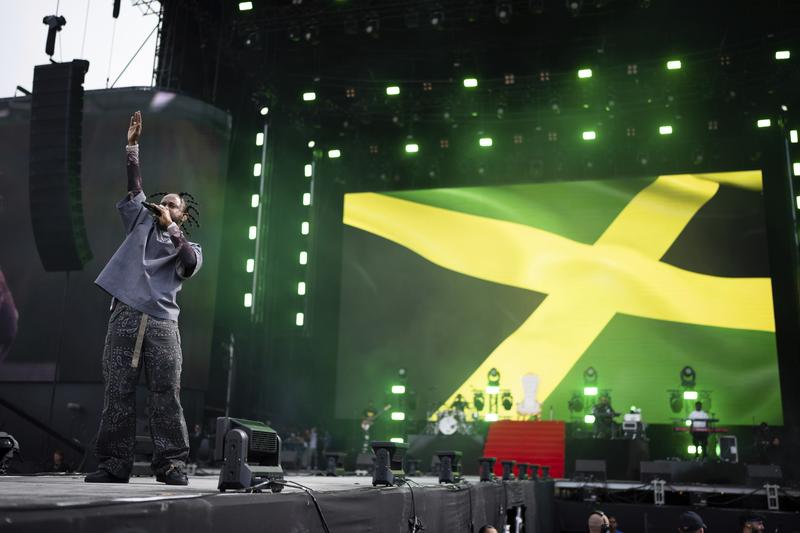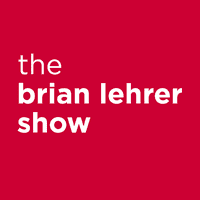The West Indian Roots of Hip Hop

( Scott Garfitt / AP Photo )
Speaker: Listener supported WNYC Studios.
[music]
Brian Lehrer: It's the Brian Lehrer Show music history special on this August 11th, considered the 50th anniversary of the day hip hop was born in the Bronx as we do some music, conversation, and some of your oral history calls. We'll finish up this special with two things. One will be a Brian Lehrer Show deep track from 14 years ago that includes DJ Kool Herc talking about his invention of hip hop as it has come to be known as his invention. DJ Kool Herc himself, and we'll take your calls and texts and tweets with your favorite rap or hip hop lyric and you can start calling now. Now, if you're holding on with a little oral history, think about a lyric.
The genre has given the English language so much, so what turn of phrase or what a couple of lines or earworms or tongue worms for you that you find yourself singing in your head or saying out loud as quotable quotes that you've woven into your day-to-day vocabulary to apply to anything in life, personal things, political things, whatever. It's an open-ended invitation to call in with a hip hop lyric that you love or identify with. If you're hanging on to do any other kind of the oral history that we've been taking, think of a few hip hop words or lines from a song that you want to throw in, 212-433-WNYC.
While your calls are coming in and you're thinking about those lines and phrases, here's that deep track from the show in 2009. We were discussing an event being staged by the group City Lore at that time about the West Indian roots of hip hop. DJ Kool Herc was on because he emigrated from Jamaica to New York when he was 10. That was in 1965. The party where everybody says he gave birth to hip hop in the Bronx was in '73. He was on with Steve Zeitlin who runs City Lore, and a third guest, Patricia Chin, who ran a record store in Jamaica before she emigrated to New York. I began by asking Steve Zeitlin, everyone knows hip hop was born in the Bronx, what's the connection with the West Indies?
Steve Zeitlin: Hip hop, of course, it's street art, and it grew out of the streets. People don't realize that there's another street scene that predates the 1973 parties of Kool, DJ Herc, and that is what was going on with people that ultimately came to New York, but at the time, were all over the different parts of the world, and it's particular in Jamaica. It's so great for me being so interested in New York City history to meet Pat Chin and to know that in 1958, Randy's Record Mart in Kingston, Jamaica was one of the places where they were beginning to notice that people in Jamaica were bringing speakers out into the parks.
They were taking the American records that were purchased, that Randy's Record Mart and they were starting to talk over them. Lo and behold, Kool, DJ Herc's family moves to New York City, and he's able to make it into something completely new here in New York. To show how it's something that, not only started in New York and went all over the world but it came from some other parts of the world too, and that a lot of different things led up to it.
Brian Lehrer: Like so many things from some other parts of the world that migrated here with other waves of immigration and became part of what we consider New York culture. It's such a New York story.
Steve Zeitlin: It's such a New York story, exactly. Of course, even VP Records and Pat Chin who started Randy's Record Mart in Kingston in 1958, also moved to New York, and reggae continue here in New York.
Brian Lehrer: That's right. We're going to play an example of one of the forms here in just a second called the toast, which is one of the models from Jamaica for the two turntables and a microphone concept. Patricia Chin, maybe you want to fill us in a little bit for people who don't know the form. What is the toast?
Patricia Chin: The toast is really the DJ. That the DJ is within the music. We usually have the music. [phone rings] Excuse me, I have to just--
Brian Lehrer: Yes, go ahead. Steve, you know about the toast too. Do you want to do the definition of toasts? Then we'll listen.
Steve Zeitlin: [laughs] Okay. Rap, of course, has one of the antecedents being the toast in Jamaica. The idea is that the DJ is actually talking over an existing record, and is creating something new and taking something that's mass-produced, which is a record, and adding a personal touch to it. In this case, taking American mass-produced records and doing these toasts over them. None of the earliest, earliest toasts were recorded, but the example that we're going to hear is an example of one of the early DJs in Jamaica, U-Roy, talking over one of the records way back in the 1960s.
U-Roy: Sons and daughters of Zion, you must not be so sad because I'm about to make you musically glad because music happens to be my musical occupation. Wait till my command.
[MUSIC - U-Roy: Cool Down Your Temper]
U-Roy: Cool down your temper, youth man. The time may be so hot, but it is got to be cool.
Brian Lehrer: On that note, let us bring in DJ Kool Herc himself. Herc, welcome to WNYC. Hi, there.
DJ Kool Herc: Good morning.
Brian Lehrer: You must remember toasts like that from Kingston in the '60s before you moved to New York. Do you think you were influenced by that for your early composing in the Bronx?
DJ Kool Herc: No, it wasn't nothing about that. I was a kid. All I know was The Skatalites, Don Drummond, Byron Lee and the Dragonaires, Toots and the Maytals, and U-Roy, and Big Youth, and I-Roy was doing things like that.
Brian Lehrer: Reggae.
DJ Kool Herc: We didn't really try to come to play reggae music for American people, but the feel of reggae music. I tried it and I used other records that have a beat to it more than a reggae beat to it. I never heard the fact that I was Jamaican. I wasn't here repping Jamaica. I was just a kid. I'm Jamaican. I was born in Jamaica when I knew what time it was for me leaving from a country coming to another country. I was there when Jamaica got its independence. I remember historic things like that. Other than the fact that I migrated to the United States and I remember those art form, but I never tried to take it away. It didn't have much to do with Jamaica.
Brian Lehrer: I hear you. The birthplace of hip hop is considered to be the rec room at Sedgwick Houses in the Bronx, where in August 1973, you threw a party with your two turntables and you on the mic. Did you have any idea it would catch on the way it did?
DJ Kool Herc: No. As far as Jamaican toasting and DJ [unintelligible 00:07:32] they use one turntable. I liked that as far as using one turntable. It wasn't two turntables, it was one because there wasn't time to go back and forth. See, back there, toasting, him and the DJ, I call it a rapport by looking back and forward and stopping the music and going back to the beginning and use a little jokes or a little slang that's safe for the time. Most likely I'd say political what's going on in the neighborhood, little catchy phrase and stuff. I was a master of ceremony, MC.
Brian Lehrer: Pat Chin, let me bring you back in here, the owner of VP Records in Jamaica, Queens. You also ran a record store in Kingston, Jamaica in the '60s and '70s. How do you remember these toasts and did you see the connection between hip hop in the US and what you call toasts in Jamaica?
Patricia Chin: Yes, they are similar. The DJs, that's what you call it, the toastmasters, they would take the rhythm and be creative and putting words, lyrics, whatever was happening at that time, to make the music more interesting. It was really a creativity of putting the music to another level because at one side of the music, there was the singing, and then it was the rhythm, and within the rhythm, the DJs would toast with their version to make the music more interesting.
Brian Lehrer: Now, Steve Zeitlin, there's an effort, I understand, to landmark that rec room at Sedgwick Houses.
Steve Zeitlin: That's right, and there's an effort to put it on the National Register. The Bronx African American Oral History Project is working on that. There's a group called Hip Hop Preserve, which is working to do that as well. City Lore is very interested in trying to support that effort to create a landmark at Sedgwick Houses.
Brian Lehrer: Part of what you do at City Lore, in general, is to preserve local history. Hip hop is one really important American contribution to music and culture that was born here in New York, although The Sugarhill Gang was actually, I think, from Englewood, New Jersey, not actually the city, but still very much of the New York metropolitan area. How do you think the history should be preserved?
Steve Zeitlin: I think that it does seem like all roads do lead back to Sedgwick Houses in '73. Afrika Bambaataa and the other pioneers, Grandmaster Flash, they were there at those parties. We do have a spot in New York that can be considered the birthplace of hip hop and I think it just would be a travesty to not see it landmarked.
Brian Lehrer: DJ Kool Herc, how do you feel about the state of hip hop today?
DJ Kool Herc: Too much scattered power, too much selfishness. They would forget where they come from that they could drop them out of the sky. A lot of people out are jacking for position and changing the blow train, making it look like they started it. That's why I'm confused right now because everybody who know their history like they should know, like a Muslim know Allah, like a Christian know God, and anybody else, this is the same thing here.
Brian Lehrer: Pat Chin, how about you?
Patricia Chin: Yes, I've seen the changes as I come along from the '60s up to now, and I would say every 10 years, you have a new set of DJs born and it's gone to a new height, but we still have to remember our roots and where it came from. To preserve that and to make the young generation know about their history. That is very important.
Steve Zeitlin: Pat, you talk about how people would not play reggae on the radio back in those days, right?
Patricia Chin: Yes.
Steve Zeitlin: It really was in the streets alone.
Patricia Chin: Yes. This was a way because the radio ads were so expensive and this was on the ground from the ghetto where it started. It was not recognized. People had to go on the street, set up their turntable with these big speakers, and that is how they learned to see what the people liked and the competition goes on. They are very creative in the rapping and the DJ. I'm very intrigued by the creativity that goes on with the rapping of the music and the DJ spinning the turntable. Everything is done at the same time so as to have the dance rolling and the people interested.
Brian Lehrer: That segment from our show from 2009, including DJ Kool Herc, who the whole world is celebrating today as creating the first hip hop moment 50 years ago today in the Bronx. We'll wrap up this music history special with a few more oral history calls from you. We'll see who is able to come up with a specific hip hop lyric, as we invited you to do, that sticks with you or that you use in your vocabulary. Trusha in Upper Montclair, you're on WNYC. Hi, Trusha. Thanks for calling in.
Trusha: Hi, how are you guys? I love the show. I listen to you guys all the time.
Brian Lehrer: Thank you.
Trusha: I have a lot of family in Queens and Queensbridge and a lot of them are related to the whole Queensbridge movement of rap, so proud about that. Yes, my line is from Nas, Illmatic, "Love changes, a thug changes, and best friends become strangers." I think that's a very true verse and anyone can relate to it.
Brian Lehrer: A pro-peace verse.
Trusha: Yes.
Brian Lehrer: Trusha, thank you very much. Daniel in San Francisco, you are on WNYC. Hi, Daniel.
Daniel: Hi, Brian. How are you today? Thanks for doing that.
Brian Lehrer: What'd you got?
Daniel: In my yearbook, we had our senior quotes. Mine was by the Beastie Boys' Professor Booty, "Life ain't nothing but a good groove, a good mixtape to put you in the right mood." Just captured everything for me. Loved making mix tapes back in the day. All about it. Anyway, thanks.
Brian Lehrer: Thank you very much. Thank you. Thank you. Cason in Asbury Park, you are on WNYC. Hi, Cason.
Cason: Hey. How are you, Brian? Mine is from Rakim, "Self-esteem makes me super superb, supreme." Hearing that as an 11-year-old shy kid that stuttered really brought me out of my shell. People like him and Kara, I sworn in the use of language, I almost equate it to almost Shakespearean. I remember one of the Allman Brothers once said that rap is crap and it would never exist or further. Look at it now. It's influenced things on an international scale as far as fashion and culture. Late '80s and early '90s, everything that happens in New York has really influenced a lot of things that's going on in the mainstream today, and hip hop has played a big role in that.
Brian Lehrer: Cason, thank you very much. Arielle in Brooklyn, you are on WNYC. Hello, Arielle.
Arielle: Hello. How you doing, Brian? My verse is from Biggie Smalls because I'm from Brooklyn, New York. I used to get up every morning. It motivated me to get up in the morning when I was in high school. One of those verses was always like, "Kick in the door wavin' the 44, all you hear was, 'Poppa, don't hit me no more.'" It used to make me just want to get up and just kick the door down and just be like, "Okay, I need to go to school. I need to do stuff." That was one of the songs that was being played constantly on the streets in Brooklyn. You just kept on singing those verses, doing lines over and over again, even on the train. It always got me up in the morning.
Brian Lehrer: Biggie Small is getting you up to go to school. Arielle, thank you very much. Kylie in Northern Virginia, you are on WNYC. Hi, Kylie.
Kylie: Hi, Brian. This has been a wonderful show. I have two really fast. One is Mary J Blige, which is just for fun and levity, hateration holleration in this dancery. I think those are words that have been introduced into our vernacular that we would not have been saying otherwise. Then one is a little heavier, it's from Nas from his song America, and he says, "Who gives you the latest dances, trends, and fashion, but when it comes to residuals, they look past us." Then the actual line is, "Woven into the fabric they can't stand us, even in white tee's, blue jeans, and red bandanas."
Brian Lehrer: Thank you, Kylie. Thank you very much. Thank you, callers. You have contributed so much. We had great guests. We had amazing oral history calls. Thank you, thank you, thank you. We hope this different kind of Brian Lehrer Show was fun, this music history special. Brian Lehrer on WNYC, have a great weekend. Stay tuned for All Of It.
Copyright © 2023 New York Public Radio. All rights reserved. Visit our website terms of use at www.wnyc.org for further information.
New York Public Radio transcripts are created on a rush deadline, often by contractors. This text may not be in its final form and may be updated or revised in the future. Accuracy and availability may vary. The authoritative record of New York Public Radio’s programming is the audio record.

